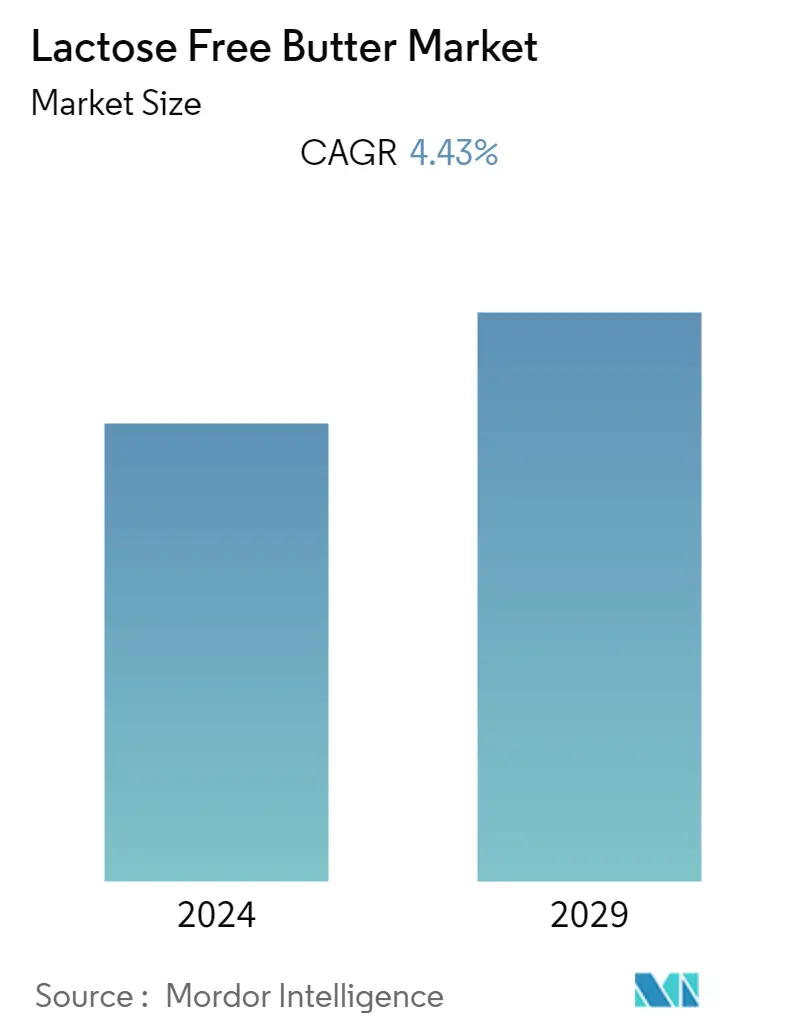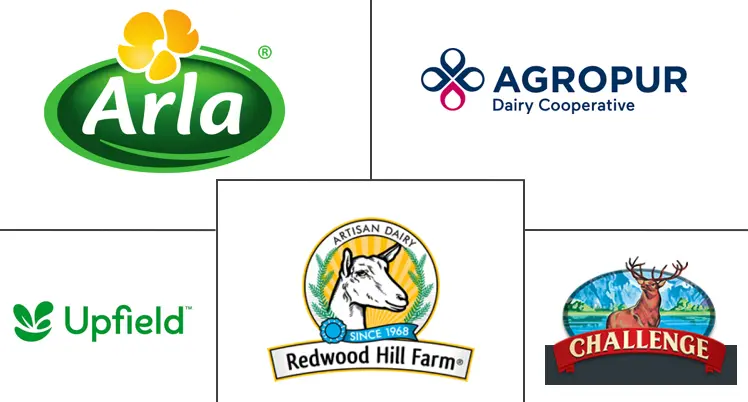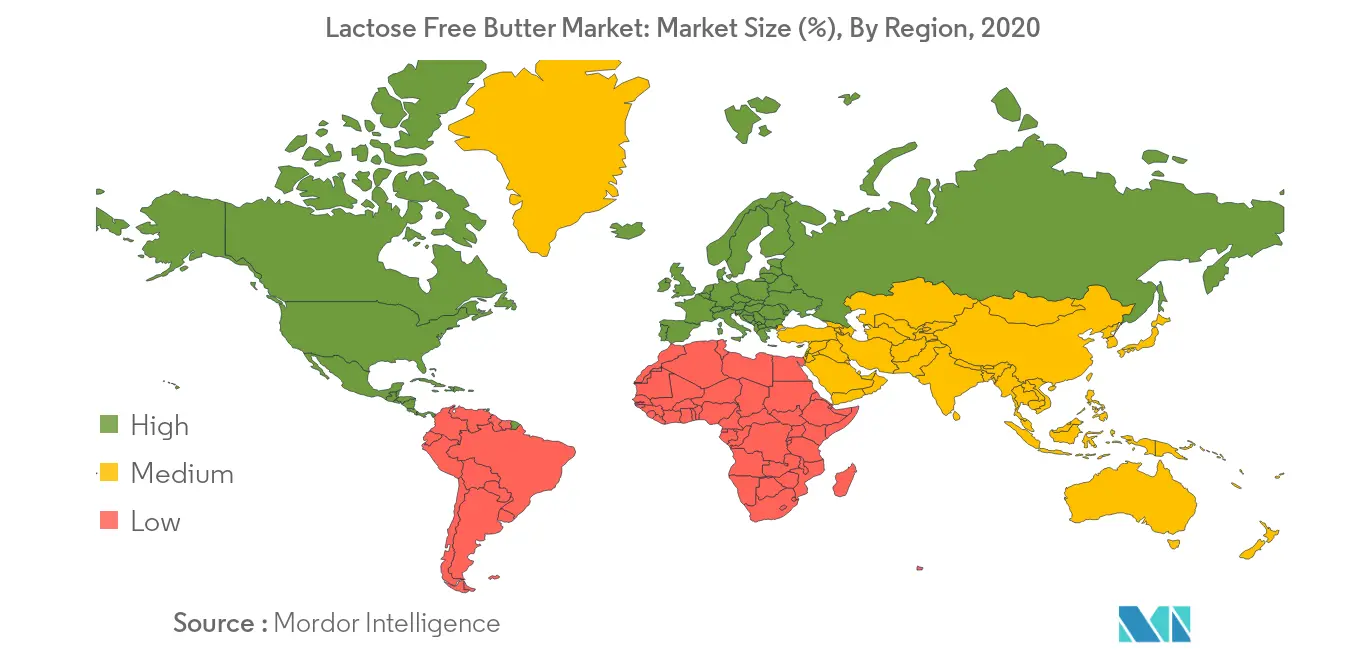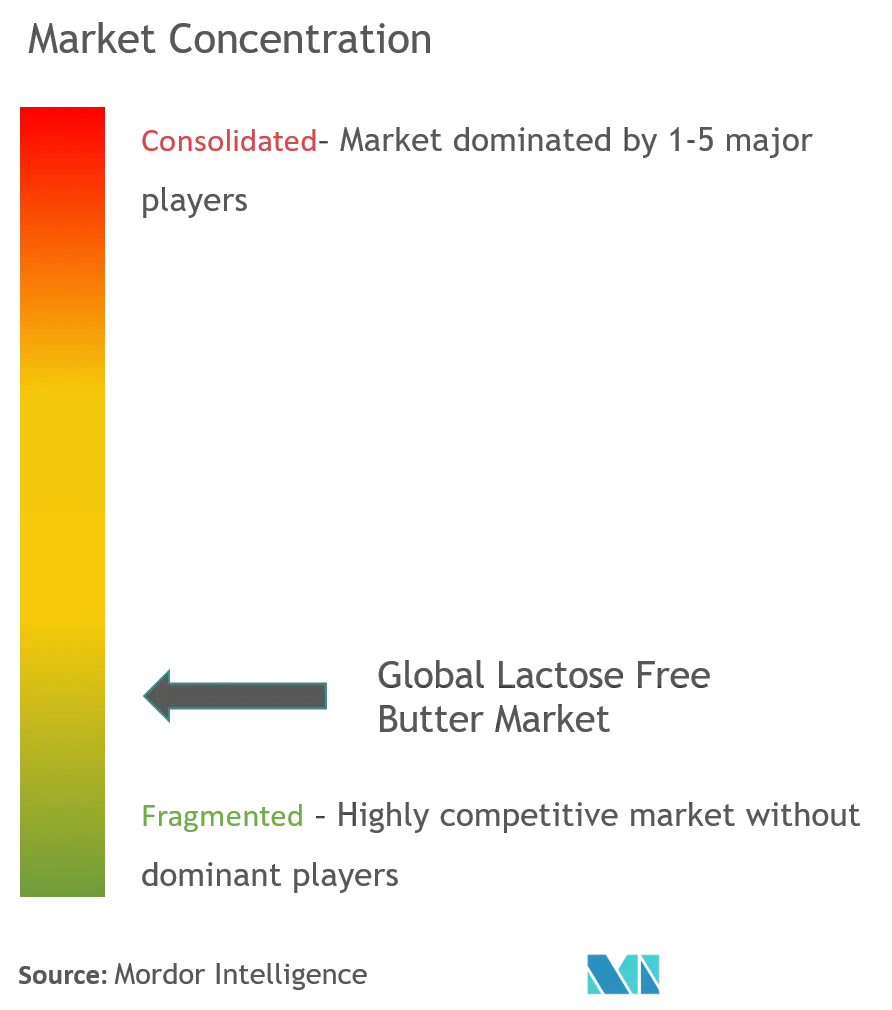Lactose-free Butter Market Size

| Study Period | 2019 - 2029 |
| Base Year For Estimation | 2023 |
| CAGR | 4.43 % |
| Fastest Growing Market | Asia Pacific |
| Largest Market | North America |
| Market Concentration | Low |
Major Players
*Disclaimer: Major Players sorted in no particular order |
Lactose-free Butter Market Analysis
The global Lactose Free Butter market is projected to grow at a CAGR of 4.43% during the forecast period (2021-2026).
- The gaining popularity of vegan diet and incidences of lactose intolerance have driven the market and continue to do so in thenear future. However, the comparatively high prices of lactose-free butter pose a challenge to the market. The presence of nutritionally equivalent alternatives such as fruit jam and margarine for a lower price affects the consumer behavior and refrains the purchase of lactose-free butter.
- Increased product launches in the market studied is an optimistic development for the market and holds promise to drive the market in future, as most of the manufactures are making developments in the sector.
- Consequently, it is creating an opportunity to capitalize on the consumer preference as the non-dairy or lactose-free butter is safe to consume and contains low amount of saturated fat.
- After, the onset of COVID-19, many countries implied a strict lockdown measures in their respective countries, which contributed to panic purchase of lactose-free butter by the consumer group leading to its increased demand.
Lactose-free Butter Market Trends
This section covers the major market trends shaping the Lactose Free Butter Market according to our research experts:
Lactose-Intolerant Consumers are the Major Boon to the Market
Lactose intolerance is a prevalent and distressing condition that affects an estimated 75% of individuals, across the globe. Consequently, the consumers opt out dairy products for it is difficult for them to digest lactose. Presently, lactose intolerance affects around 40 million Americans or 1/3 of the population, in various degrees of severity. It is most prevalent among the adults of East Asian descent, by affecting more than 90% of adults in some of these communities. Additionally, lactose intolerance is also very common in people of West African, Arab, Jewish, Greek, and Italian descent. Thus, indicating a huge growth opportunity for lactose-free butter in the global market. However, various studies have shown that a consumer with lactose-intolerance can easily consume butter in a minimal quantity for it contains very low amounts of lactose. Nonetheless, with the introduction of lactose-free butter in the market, it created an opportunity for the lactose-intolerant consumer to consumer butter in the desired quantity.

North America is the Largest Market
The surging number of North American population who suffer from lactose intolerance are creating the demand for lactose-free butter. The consumers of the region, especially United States and Canada are highly aware of the lactose intolerant condition unlike the consumers of Asia-Pacific and other parts of the globe that are unaware of the condition they are suffering from. Therefore, the demand for lactose-free butter is higher in North America. Additionally, due to the growing health-consciousness among the native consumers of Guatemala, a trend of shifting from dairy to lactose-free butter and other alternatives is observed as a precautionary step by the consumers themselves. This is attributed to the fact that a significant portion of the country's population already suffers from lactose-intolerance.

Lactose-free Butter Industry Overview
The global lactose-free butter market is fragmented with key players dominating the market share such as Arla Foods amba, Challenge Dairy Products, Inc., Redwood Hill Farm & Creamery (Green Valley), Agropur cooperative and Upfield Canada Inc. The market is witnessing new entrants at a fast pace due to the higher market potential and low market entry barriers. The surging demand of lactose-free butter by the lactose intolerant consumers offers an opportunity for product development in the regions of high demand and for market development in the region where the availability is still restricted. Also, in the competitive market the product offers a scope of diversification in order to cope up with the competition.
Lactose-free Butter Market Leaders
-
Arla Foods amba
-
Challenge Dairy Products, Inc.
-
Redwood Hill Farm & Creamery (Green Valley)
-
Agropur cooperative
-
Upfield Canada Inc.
*Disclaimer: Major Players sorted in no particular order

Lactose-free Butter Market Report - Table of Contents
1. INTRODUCTION
- 1.1 Study Assumptions and Market Definition
- 1.2 Scope of the Study
2. RESEARCH METHODOLOGY
3. EXECUTIVE SUMMARY
- 3.1 Market Overview
4. MARKET DYNAMICS
- 4.1 Market Drivers
- 4.2 Market Restraints
-
4.3 Porter's Five Forces Analysis
- 4.3.1 Threat of New Entrants
- 4.3.2 Bargaining Power of Buyers/Consumers
- 4.3.3 Bargaining Power of Suppliers
- 4.3.4 Threat of Substitute Products
- 4.3.5 Intensity of Competitive Rivalry
5. MARKET SEGMENTATION
-
5.1 By Type
- 5.1.1 Salted Butter
- 5.1.2 Unsalted Butter
-
5.2 By Distribution Channel
- 5.2.1 Supermarkets/Hypermarkets
- 5.2.2 Specialty Stores
- 5.2.3 Convenience Store
- 5.2.4 Online Retail Stores
- 5.2.5 Others
-
5.3 Geography
- 5.3.1 North America
- 5.3.1.1 United States
- 5.3.1.2 Canada
- 5.3.1.3 Mexico
- 5.3.1.4 Rest of North America
- 5.3.2 Europe
- 5.3.2.1 Spain
- 5.3.2.2 United Kingdom
- 5.3.2.3 Germany
- 5.3.2.4 France
- 5.3.2.5 Italy
- 5.3.2.6 Russia
- 5.3.2.7 Rest of Europe
- 5.3.3 Asia Pacific
- 5.3.3.1 China
- 5.3.3.2 Japan
- 5.3.3.3 India
- 5.3.3.4 Australia
- 5.3.3.5 Rest of Asia-Pacific
- 5.3.4 South America
- 5.3.4.1 Brazil
- 5.3.4.2 Argentina
- 5.3.4.3 Rest of South America
- 5.3.5 Middle East and Africa
- 5.3.5.1 South Africa
- 5.3.5.2 Saudi Arabia
- 5.3.5.3 Rest of Middle East and Africa
6. COMPETITIVE LANDSCAPE
- 6.1 Most Active Companies
- 6.2 Market Share Analysis
-
6.3 Company Profiles
- 6.3.1 Arla Foods amba
- 6.3.2 Challenge Dairy Products, Inc.
- 6.3.3 Redwood Hill Farm & Creamery (Green Valley)
- 6.3.4 Agropur cooperative
- 6.3.5 Upfield Canada Inc.
- 6.3.6 OMIRA GmbH (minusL)
- 6.3.7 Butterfelds Butter, LLC
- 6.3.8 Prosperity Organic Foods, Inc. (MELT Organic)
- *List Not Exhaustive
7. MARKET OPPORTUNITIES AND FUTURE TRENDS
8. IMPACT OF COVID-19 ON THE MARKET
** Subject To AvailablityLactose-free Butter Industry Segmentation
The lactose free butter market is segmented by type, by distribution channel and by geography. By type, the market is segmented into salted and unsalted butter. By distribution channel, the market is segmented into supermarkets/hypermarkets, specialty stores, convenience store, online retail stores and others. Furthermore, the report also takes into consideration the market for gummy vitamins in established and emerging economies, including North America, Europe, Asia-Pacific, South America, and Middle East & Africa.
| By Type | Salted Butter | |
| Unsalted Butter | ||
| By Distribution Channel | Supermarkets/Hypermarkets | |
| Specialty Stores | ||
| Convenience Store | ||
| Online Retail Stores | ||
| Others | ||
| Geography | North America | United States |
| Canada | ||
| Mexico | ||
| Rest of North America | ||
| Geography | Europe | Spain |
| United Kingdom | ||
| Germany | ||
| France | ||
| Italy | ||
| Russia | ||
| Rest of Europe | ||
| Geography | Asia Pacific | China |
| Japan | ||
| India | ||
| Australia | ||
| Rest of Asia-Pacific | ||
| Geography | South America | Brazil |
| Argentina | ||
| Rest of South America | ||
| Geography | Middle East and Africa | South Africa |
| Saudi Arabia | ||
| Rest of Middle East and Africa |
Lactose-free Butter Market Research FAQs
What is the current Lactose Free Butter Market size?
The Lactose Free Butter Market is projected to register a CAGR of 4.43% during the forecast period (2024-2029)
Who are the key players in Lactose Free Butter Market?
Arla Foods amba, Challenge Dairy Products, Inc. , Redwood Hill Farm & Creamery (Green Valley), Agropur cooperative and Upfield Canada Inc. are the major companies operating in the Lactose Free Butter Market.
Which is the fastest growing region in Lactose Free Butter Market?
Asia Pacific is estimated to grow at the highest CAGR over the forecast period (2024-2029).
Which region has the biggest share in Lactose Free Butter Market?
In 2024, the North America accounts for the largest market share in Lactose Free Butter Market.
What years does this Lactose Free Butter Market cover?
The report covers the Lactose Free Butter Market historical market size for years: 2019, 2020, 2021, 2022 and 2023. The report also forecasts the Lactose Free Butter Market size for years: 2024, 2025, 2026, 2027, 2028 and 2029.
Lactose-free Butter Industry Report
Statistics for the 2024 Lactose-free Butter market share, size and revenue growth rate, created by Mordor Intelligence™ Industry Reports. Lactose-free Butter analysis includes a market forecast outlook to 2029 and historical overview. Get a sample of this industry analysis as a free report PDF download.



